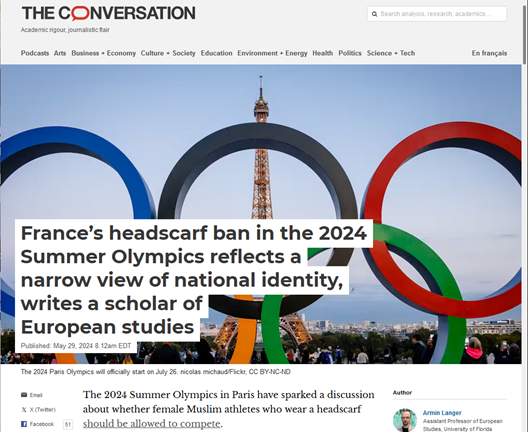Trashing Secularism in France is a Favourite Anglo Sport
2024-06-04
My analysis of yet another example of the English-language media totally misunderstanding—and deliberately misrepresenting—secularism in France. The underlying cause is the anti-universalist ideology prevalent in the Anglo-American world.
Sommaire en français Mon analyse d’un autre exemple de médias anglophones qui méconnaissent totalement — et déforment délibérément — la laïcité en France. La cause sous-jacente est l’idéologie anti-universaliste qui prévaut dans le monde anglo-américain.
One of the favourite sports of Anglo media is to defecate on secularism in France, deploring the sad fact that the French do not do everything just like Americans or Anglo-Canadians. A recent article in The Conversation by Armin Langer, “France’s headscarf ban in the 2024 Summer Olympics reflects a narrow view of national identity, writes a scholar of European studies”, is an example of such arrogance and dishonesty. Some highlights:
- Langer fails to distinguish between religious belief and religious practice. Bans on religious symbols affect only the latter, never the former.
- Langer states that religious symbol bans discriminate against persons, in this case Muslims, specifically Muslim women. This is false. Such bans are behavioural. They ban certain behaviour, wearing religious symbols in certain contexts. They do not ban persons. A religious symbol can be removed and put back on after leaving the context where the ban applies. If a person refuses to remove their symbol, they are excluding themselves and are responsible for their own behaviour. The State or athletic organization is under no obligation to accommodate every whim of employees and participants.
- Langer laments the ban on religious symbols worn by Olympic athletes, claiming that “no one should impose on a woman what she needs to wear, or not wear.” This is nonsense. Does Langer think that female police officers need not wear the uniform? Or that women need not obey the hardhat rule on constructions sites which impose such safety regulations? Or that female medical workers need not respect medical hygiene by dressing appropriately?
- Langer laments the ban on religious symbols worn by pupils in French schools, claiming that it causes “feelings of exclusion and isolation.” The reality is quite the opposite. Langer fails to mention that the academic performance of daughters of Muslim parents has significantly improved in the decades since the ban was imposed in schools in France, because those girls are less isolated thanks to the ban.
- Langer refers to multiculturalism as if it were a good thing, whereas the French are fully aware that that ideology is anti-universalist, hence incompatible with secularism.
- Even the title is dishonest: there is no “headscarf ban.” The bans apply to all religious symbols. Furthermore, the term “headscarf” implies that the Islamic hijab is just an article of clothing, when in reality it is the banner of a supremacist, misogynist ideology and a symbol of rape culture.
- Langer refers to the hijab as “an expression of religious identity and empowerment.” Identity, yes! But the only people who are empowered by the hijab are religious fanatics and Islamists.
There is a major theme that runs throughout this appalling text by Langer. That theme is mainly implicit, but becomes explicit when the author says that we must not tell women what to wear or not to wear. That theme could be called “impunity for the oppressed” and it is a consequence of a toxic ideology, neoracism (which falsely claims to be antiracist and is based on intersectionality and Critial Race Theory or CRT), an ideology which is anti-universalist and anti-Enlightenment (hence anti-European). Neoracism has corrupted every social movement it has touched, including of course antiracism (but not limited to that issue). It divides the world into two categories of people, (1) the oppressors or dominant, and (2) the oppressed or dominated. The former are always bad and wrong, while the latter are always right and good. Hence, “impunity for the oppressed.”
According to the neoracist worldview, oppression (such as racism, sexism, etc.) is always a one-way street, with the dominant always oppressing the dominated. For example, racism is a one-way street by which “whites” (i.e. those of European descent) are always racist towards non-whites, whereas non-whites are never racist. Furthermore, white-on-white racism and non-white-on-non-white racism simply cannot and do not exist in this worldview. Furthermore, neoracists have a strong tendency to racialize (i.e. essentialize) religious affiliation, especially Muslimness, thus turning Islam into a “race” (which of course it is not) and allowing neoracists to accuse critics of Islam of “racism” as a form of social censorship.
Women are classified as an oppressed category (hence the stupid idea that women must not be subject to dress codes), as are Muslims. Partisans of neoracism classify Islam as the religion of oppressed non-Europeans (hence non-“whites”) and grant Muslims impunity (which is of course an enormous privilege, but neoracists only use that word “privilege” when speaking of “white” men). Thus, Muslim women are, according to neoracists, triply oppressed: as women, as Muslims and as non-Europeans. They can do no wrong. If Muslims or Muslim women experience problems related to their religion, those problems cannot be the fault of the religion itself (when in fact such is often the case, because Islam is very misogynistic and utterly rejects freedom of conscience); rather, the fault must be with “Islamophobia” directed against them by non-Muslims. Thus Muslims must be granted the privilege of wearing religious symbols when everyone else has to obey certain restrictions in certain contexts. All this happens, of course, to the great delight of Islamists.
What antisecularists like Langer are promoting is not equality. They promote the maintenance of religious privileges, especially for fanatical Muslims, those who intransigently refuse to follow the rules which secular States like France apply to everyone.
Next blog: Ideological Capture

